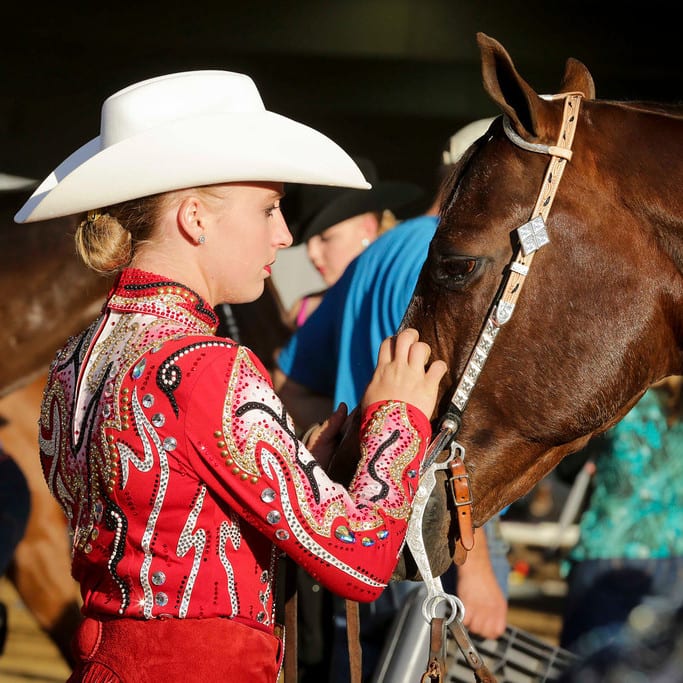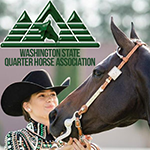Every January people ring in the New Year with resolutions and talk of things they want to change. This year, as 2015 came to a close, I decided to ask people to share questions they had always wanted to ask a judge.
Many of the questions were asked multiple times in a variety of ways, while others were just thought provoking. The list could represent any year in the horse show world. To help get answers, I reached out to many other fellow judges for their opinions. Check out the list to see if a question you have always had made the list of top 15 questions.
Question #1 – At the big shows with three to five judges for one class, how can a group of judges see the same class so differently?
A: There are a variety of reasons why this happens. And while every situation is unique, the causes fall into a couple of categories. Either the judges positioning in the arena did not present the same class to all judges or the quality of the class was such that multiple outcomes were correct.
Often the performances are such that there are multiple ways to place the class. This is especially true with exceptional quality. But it can also happen in cases where there are multiple faults making it difficult to separate performances. For instance, one horse is over-canted, another is a poor jogger and a third horse creeps along at the walk. None are credit earning yet the horse must be ranked in order. Sometimes the winner is very obvious but in other instances that is simply not the case.
Every exhibitor has had a ride where his or her horse was really good at one en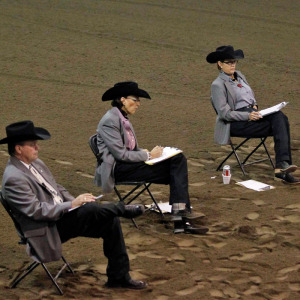 d, but terrified at the other, took a wrong lead, jumped off the rail or stumbled. The error may happen quickly and the horse or rider recovers as if nothing happened. One judge may have seen the whole incident while another caught only a glimpse of the recovery and a third saw nothing at all. Each judge will mark his or her card according to what they saw.
d, but terrified at the other, took a wrong lead, jumped off the rail or stumbled. The error may happen quickly and the horse or rider recovers as if nothing happened. One judge may have seen the whole incident while another caught only a glimpse of the recovery and a third saw nothing at all. Each judge will mark his or her card according to what they saw.
The judge’s vantage point can greatly affect his or her score as well. Take showmanship for example. If one judge sits just behind the steward, they will be able to see whether or not exhibitors are approaching the steward from a straight line while the judges who sit two or three chairs from the steward will not be able to see this line.
In reining, judges sitting in the center chair can easily miss a horse being out of lead coming straight at them or going straight away. Placement of the judges in the arena makes a difference in the performances they see. It is also possible that at the exact moment the judge looked down to mark a score, something happened and they miss what happened.
Every class has to be judged in the context of that class only, not against a previous performance and not against a record. Often bystanders are extremely familiar with the horses and exhibitors at the show. They have had the time to watch, study and both fall in love with or criticize one characteristic or another.
Question #2 – What do you do when one judge is waving you on and the other two or three have their heads down?
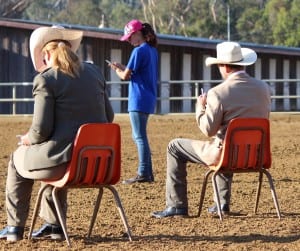 A: This is such a great question and one that exhibitors often wonder about. Anxious to make a good impression, exhibitors often feel they must leave the cone when one judge is waving them to start even though the other judges still have their heads down. So what should an exhibitor do?
A: This is such a great question and one that exhibitors often wonder about. Anxious to make a good impression, exhibitors often feel they must leave the cone when one judge is waving them to start even though the other judges still have their heads down. So what should an exhibitor do?
Exhibitors should look directly at the judge who is looking down or not yet ready and not at the judge who is waving them on course. It takes a confident rider to hold the ready position and stay on their plan.
For Carla Wennberg, “Those kids are smart that wait for the judges to be ready. I understand horses are either hot or dull at the cone. It is the exhibitors that have a thought process that I am going to give credit to. It goes with being confident and having a plan.”
Carla wants, “Exhibitors to look at me and tell me they are the winner.”
As a coach, Carla wants the judge to look over at her students and say “yes”, here is my winner. “I tell students every time the judge looks, you have to be yes.”
Question #3 – How much does it hurt you when your horse pivots on the wrong foot in horsemanship?
A: “In horsemanship there is no fault or penalty assessed for the horse not turning on the correct hind foot,” indicated Brad Kearns.
“When the turn revolves around the outside hind leg the horse is not correctly balanced. However, the horse is not required to hold a pivot foot when spinning. Instead, the horse should maintain balance and cadence throughout the turn,” Brad continued.
Patterns give judges a means to evaluate a rider’s ability to communicate with their horse by testing their skills through a set of maneuvers. When a horse turns incorrectly, the judge is alerted to look for flaws in the rider’s position or communication.
The degree to which the rider causes the horse to turn improperly and the degree to which the horse turns incorrectly both affect the score. A well-positioned rider, who cues correctly with the horse only occasionally switching his or her stationary leg, will not receive a negative score for the maneuver.
A horse that maintains balance on the outside hind leg during the turn is not in the correct position to maintain a fluid turn and can result in the horse striking one leg with the other, hollowing out, getting out of the bridle or putting the rider out of position for the next maneuver, none of which are credit earning. Behavior of the horse is judged as a result of the rider’s actions. If the rider causes the horse to turn improperly or the horse shows resistance or ends up out of position, the maneuver will receive a negative score.
Question #4 – What stands out as a great performance?
A: Greatness is difficult to describe. It is the result of passion, dedication, devotion to a strong work ethic and an expectation of clear results. It epitomizes the height of success and we know it when we see it.
Great performances look easy and have a level of grace that others lack making each stand out in a different way. Some riders present a quiet confidence while others attack a class with boldness. Either way, winning exhibitors have a plan, communicate with confidence and appear to be one with their horse. The best exhibitors make it obvious they love what they are doing – win or lose.
Gold Medal winner Denny Emerson said, “When you watch a really gifted rider sitting the gaits, it appears that the spine of the rider ‘grows out of ‘ the spine of the horse, as if to create on entity.” He goes on to say that, “great riders even out the irregularities of the horses they ride.”
There is simply not any one characteristic that makes a great performance. It is the combination of all the above that comes together at the exact moment necessary to create the ultimate ride.
One thing is for certain, great performers ride a confidence lacking in the average performance. They ride for a greater purpose than simply to win. They ride to prove that they can.
Question #5 – Is it okay to keep attire in Ranch Riding simple or does it need to duded up with fancy chinks, slickers and ropes?
A: Absolutely – keep it simple if that is your personal style – or dress up in your favorite throw back ranch wear if you prefer. Regardless of whether you choose to wear chinks, chaps or jeans this is a question abounds style and as such, not used in the criteria to evaluate an exhibitor’s performance.
2015 Reserve World Champion Abby Cosenza agrees, “I feel that tack and rider attire should reflect that of the working western horse. A clean crisp simple ranch look is what makes this class so much fun. I have seen ropes, hobbles and wide stirrups, which are pretty cool but not necessary. I believe a breast collar and back cinch are a must. I prefer a clean, simple western look, allowing the majority of focus to be on the horse and it’s performance.”
No matter how an exhibitor chooses to dress themselves or their horse, putting together a great run and having fun while doing it is what horse showing is all about.
Question #6 – What about the horses that continue to win that do not perform the gaits correctly?
A: APHA Director of Judges, Dave Dellin, answers this best, “I think the real key to understanding placings revolves around looking at the class as a whole, not judging a single horse’s performance and especially not picking out a negative fault of a single performance.”
“A class can be won with a very low score, even far below average, if it is still the best performance in that particular class. That is why it is so difficult to know if a class is placed well, unless you score the entire class. If you sit and score an entire class, the same as the judges do, you will find that a vast majority of the time, placings are almost always within the appropriate ‘grouping’ in a class,” Dellin continues.
“Grouping of horse show classes is very similar to how race horses are grouped. Think about it this way. If a single horse wins by 10 horse lengths, everyone knows who the winner is.If three horses cross the finish line at the same time, they need a photograph to determine the winer. It may be the fastest track time ever or the slowest, it really doesn’t matter as long as they can determine the order they crossed the finish line.”
Sometimes a single horse stands out so much everyone agrees on the winner. Sometimes they all have different faults, and the placings will be spread around between several horses. This certainly doesn’t mean the judging isn’t correct, it only means there were several very close performances in that class.
Question #7 – How does a horse pinning his ears in showmanship affect the score?
A: A horse that lays his or her ears back when they go to work will not affect the score in a showmanship class. But if the ears are continuously pinned or if they are combined with a twisted neck, grinding teeth or resentment the exhibitor will not earn credit. The outcome has much more to do with the resistance or reluctance to perform than the ears themselves.
Charlene Carter finds it undesirable and indicated that, “An exhibitor has to be at the very top of the game to overcome showing a horse that does not like its job.” Charlene also finds that when a horse is very bad with his or her ears, her first thought is to, “watch for a lameness issue or intimidation.” Like so many of the other questions, the answer depends on the degree of the infraction.
Question #8 – In showmanship, if your horse stops squarely at the setup, should you keep it or make an adjustment?
A: Keep it – you worked hard to teach your horse to stop squarely. Moving the horse’s feet once squared raises doubt in the judge’s minds as to the exhibitor’s control and/or knowledge.
There is also an inherent risk that the horse will not setup the second time as well as he or she did the first time. It can be automatic to adjust the horse’s feet, but that too is part of the test of showmanship. Judges are looking for exhibitors who have command over the horse’s movement.
And if the exhibitor just got lucky, hopefully they take advantage of it and don’t appear shocked!
Question #9 – How do you handle riders who are schooling in the arena?
A: Nancy Sue Ryan understands that “Corrections in the show arena are sometimes necessary but should be done at a minimum and very discreetly.”
On the flip side, Nancy Sue feels, “If the horse is entered repeatedly in classes solely to be schooled or trained on in an abusive manner will only build resistance.”
Like so many of the questions, the answer depends on the degree to which the rider corrects the horse. There is a difference between a rider guiding the horse and a rider making a harsh correction. It is up to the rider to p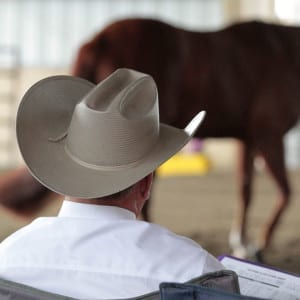 rotect and guide their horse. Riders are training their horse with every interaction, including in the show ring.
rotect and guide their horse. Riders are training their horse with every interaction, including in the show ring.
Like Nancy Sue, many judges find it, “disrespectful to others exhibitors who are trying to show their horse when an exhibitor stops and backs up or schools in an excessive manner.”
When judging, Nancy Sue, “will ask an exhibitor to stop disrupting the class one time. The next time I see someone school they will be asked to watch the class with me from the center of the arena.” Period. She went on to explain, “Excessive schooling in the show arena is not what the outside spectator came to watch. As trainers and exhibitors we need to continue to respect our horses, our clients and out industry.”
The most successful riders in the show ring know that today is not the last show for their horse. They make every effort to ensure today’s ride does not leave the horse resentful, expectant of discipline or free to take charge when they enter the show ring.
Making the correction appropriate for the situation is the key to providing longevity and a happy horse in the show ring. Most of the time it requires the rider to predict and prevent the mistake rather than react to the situation once the mistake has happened.
Question #10 – What do you pay attention to, the worst horse, the best horse, or the biggest wreck?
A: Judges find their way to this answer with experience. New judges may be drawn to study the good, the bad or the ugly but over time judges learn to distinguish when a bad situation is about to become a wreck and needs to be stopped and when an exhibitor is having a bad ride.
It is easy to be drawn in by one exhibitor or another. If a judge spends all his time watching the most beautiful mover in the class, they will find themselves panicked when the class is called to the line up. Horses that are misbehaving demand that judges pay close attention but not so much that the judge does not continue to evaluate the rest of the class.
Like great riders, great judges can feel when behavior is escalating out of control, hear the build up of tension or sense something is happening behind them. Over time judges develop a system that allows them to appreciate the beauty, assess the faults and compare all exhibitors in a class.
Question #11 – Is it true that loud-colored horses are sometimes overlooked because of their color?
A: This may appear to be the case in some classes but it is more often the case that one color or another stands out or hides more readily than others. Whether it is against white wall or in an outdoor arena, horses show and look better in some scenarios. Unusual colors can be seen as an attribute that draws the judge’s attention to the horse but the unusual color or trait may just as easily draw attention to a negative characteristic. For instance, white markings that go above the knee can draw attention to a horse that already uses too much knee.
Chris Thompson reflected, “The only color I ever notice is healthy, shiny and happy horse!” Like Chris, most judges are not prejudice to horses of an unusual color. Of course there could always be a judge that truly dislikes a particular color and may hold it against an exhibitor but this can be true for any attribute.
Question #12 – How do judges feel about the extreme drape often seen in trail, western pleasure or horsemanship?
A: Often it is the case that the best performance wins in spite of a flaw or an undesirable trait not because of it. Excessive drape falls into this category. Judges do not want to see too much drape in the reins in any class and it is not the reason a horse wins.
Clint Fullerton tells riders, “A draped rein in horsemanship is completely unacceptable and is the most common mistake that I see. In the pleasure, I want to see a horse on a loose rein but an excessive drape in the rein gives a sloppy look to the overall presentation.”
Exhibitors always need to keep the context of the class in mind when reviewing the placings.
Question #13 – Do judges ever see riders take a quick jerk on the horse and how do they handle it?
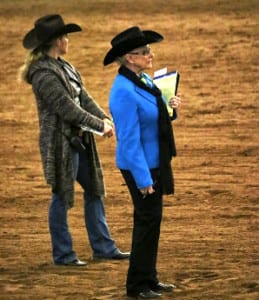 A: Exhibitors may not know that judges, like teachers, have eyes in the back of their heads. Although judges sometimes may catch a rider take a quick hard jerk, more often than not, the exhibitor takes a quick pull behind the judge’s back.
A: Exhibitors may not know that judges, like teachers, have eyes in the back of their heads. Although judges sometimes may catch a rider take a quick hard jerk, more often than not, the exhibitor takes a quick pull behind the judge’s back.
Even so, the horse almost always tells on their rider. Judges are likely to see the after effect of the correction through a horse’s pained expression, over-bridled frame, gapping mouth or poor behavior.
And judges do remember how an exhibitor treats their horse. Actions are memorable and like the horses themselves, trust is hard to regain once broken. With the ever-increased public awareness and interest in animal welfare, judges are under pressure to see and respond accordingly to excessive schooling methods in the show ring.
Question #14 – How much attention do judges pay to the bling?
A: This was definitely the number one question on exhibitor’s minds. And like so many questions regarding judging horse shows, the answer is not as simple as it seems.
In a judge’s evaluation what matters is that the presentation is professional – the outfit enhances the shape of the exhibitor’s body, the saddle fits the rider and the horse. Everything should be tailored to allow the exhibitor to put in a great performance. Whether it is on the rider’s back or the horse’s back, quality and fabrication is important. Everything should create clean smooth lines from head to toe.
Extra steps are taken to produce high quality goods. All of the extras that make the difference in the way a garment, a saddle, a pad or a blanket fit raise the cost of production. Exhibitors are better off buying one well-tailored well-made outfit that will withstand the rigors of the show ring than to have a variety to choose from. And just like when making any other retail purchase the quality of each purchase must be weighed against the cost and longevity expected.
Judges notice when a saddle does not fit properly leaving the rider out of position. They notice when a saddle pad is too short; the saddle rubs the horse’s hip; the exhibitor’s hat is misshapen; a shirt will not stay tucked in or numbers sit so low the horse twitches to avoid the numbers rubbing his or her flank.
Quality matters in all that we do. A quality saddle that is well cared for lasts a lifetime and retains its value. Buy a great hat – one that will hold its shape. Do not get caught up in fads or styles of the season. It is not about style but it is about a well-tailored fit.
If an exhibitor wants to show their personality, throw in a wild colored scarf. Nothing should distract the judge’s eye from what he or she is judging. Everything about the exhibitor’s presentation should enhance their ability to perform and allow the judge to evaluate their performance.
Question #15 – How far should I back when the pattern calls for two horse lengths, four steps, or two strides?
A: Good question. And one that when asked, may or may not be asked with a specific answer in mind. Holly Hover finds that most often when the pattern says, “back four steps” the judges simply want to see the exhibitor back a few steps. Holly has taken a proactive approach to avoid focusing on the exact number of steps – her patterns call for exhibitors to, “Back a few steps.”
“I think when a pattern calls for the exhibitor to back two horse lengths judges want to see exhibitors back five or six steps not fifty feet,” Holly advised.
“A horse is approximately 12 feet from head to tail so backing a horse length would be about three steps providing the horse takes a two foot step when backing, “ Holly continued.
A stride is the full rotation of the legs and a step is an individual footfall. Typically judges count the steps the horse takes with his or her front legs. This is true whether astride or at the horse’s head in showmanship. As with any element of a pattern, when a pattern calls for a specific count, the exhibitor’s focus should remain on performing the maneuvers as precisely as possible in keeping with the overall performance.
For instance, a pattern calls for exhibitors to back six steps then turn and walk to the judge and set up for inspection. If there is not room for the exhibitor’s 17 hand horse to get six steps in, the exhibitor has a choice – back exactly six steps and walk a crooked line to the judge or back until even with the judge and walk in a straight line to the judge.
How the exhibitor chooses to perform the pattern is part of the judge’s evaluation. Judges are looking for an exhibitor’s ability to make the correct decisions once on course; it is part of the test of the exhibitor’s skills as a horseman. While precision is important, it must be kept in perspective with the overall performance. The best advice? Never stop showing regardless of what kind of mistake you think you may have made.
Thank you to all who sent in questions. Keep them coming. Happy Showing in 2016!
Photos © Delores Kuhlwein, Carey Nowacek, The American Quarter Horse Journal, Shelby Layne Ridgeway
About Stephanie Lynn: Professional Horseman Stephanie Lynn coached her first AQHA World Champion in 1988. She has since coached, trained and shown World, Congress and Honor Roll horses across disciplines. She is a judge for AQHA, NSBA and APHA and has judged World Championship shows for each association. Most recently, Stephanie is the author of The Good Rider Series and A Lifetime Affair: Lessons Learned Living My Passion. The Good Rider Series is a library of resource material that is both practical and applicable in the barn and show ring for riders. Stephanie can always be reached through her website: http://www.stephanielynn.net.


